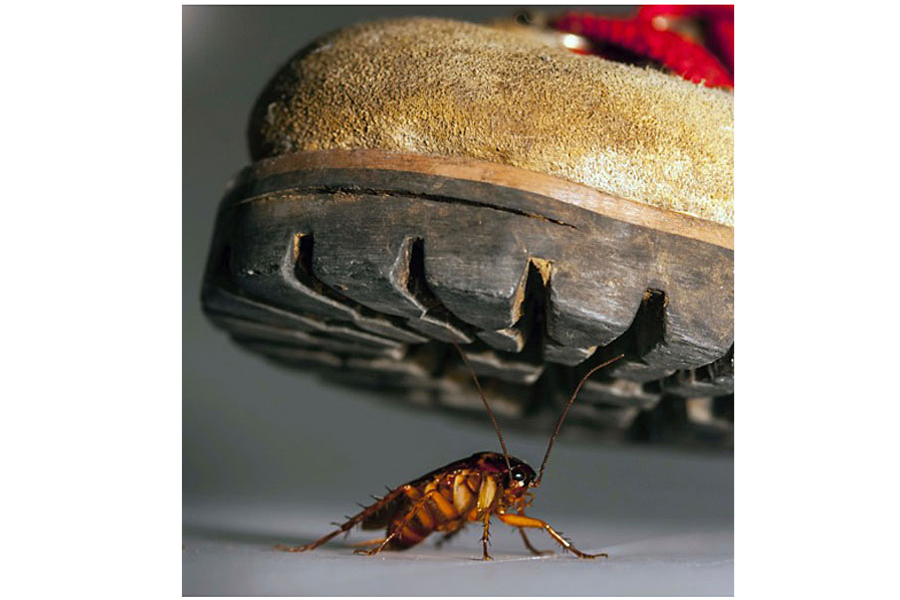Robo-roach to the rescue? Creepy bugs inspire lifesaving technology.
Loading...
Cockroaches are known for being sneaky, speedy, and impossible to kill. They can slip through cracks so small they don't seem to exist and run away uninjured from the crushing blow of a boot.
The insects may be a nuisance, but scientists say the pests have more to offer than a chill down your spine.
After observing cockroaches accomplishing incredible feats of body contortion, scientists developed a way to harness the bugs' creepy abilities for good. Inspired by the cockroaches, they designed a prototype robot that could one day slip through small spaces in rubble to assist in search-and-rescue missions.
"You never know where fundamental, basic research will lead," study author Robert Full tells the Christian Science Monitor in an interview. "Something that is one of nature's most revolting animals can teach us design principles that could some day lead to a robot that could save your child in an earthquake."
The researchers, Dr. Full and Kaushik Jayaram, put the real roaches through a barrage of tests to evaluate their skills. Their findings are reported in a paper published Monday in the journal Proceedings of the National Academy of Sciences.
American cockroaches, the most common roach, ran through obstacle courses, squeezing through spaces about one quarter their body height, the same height of two stacked pennies, and running at top speeds through tight spaces. Even compressed in a vertically-limited space, with their legs splayed out to their sides, the speedy critters could run at 20 body lengths per second. That's like a human sprinting 70 miles an hour, Full says.
The researchers also tested the animals to see how much compression pressure they could withstand. The resilient roaches walked away from pressures of nearly 900 times their own body weight uninjured. They could even wriggle through a crevice that exerted compression forces of about 300 times their body weight.
How does the bug do it?
The researchers discovered that the cockroach's exoskeleton is kind of like origami. It's made up of rigid plates connected by flexible tissue, so it can be flattened without being broken.
When compressed, the insects' legs splay out just as you might expect. But they are still able to gain traction. The bugs can scuttle along by using the friction from the surfaces both above and below them.
Robot to the rescue
The robot, dubbed CRAM or Compressible Robot with Articulated Mechanisms, mimics the sneaky cockroach's ability to squeeze through seemingly impossible crevices and continue to run in a compressed space. The scientists built an exoskeleton and legs like those of the flexible, durable cockroaches.
This kind of robot could be useful in investigating a pile of debris for survivors in a collapsed building or other potentially treacherous situation for first responders, without collapsing the structure in further. In theory, robots like CRAM could be deployed in swarms, exploring rubble and reporting back if there are survivors trapped, if it's safe for humans to move in, or other potentially lifesaving data.
"This sort of a narrow opening would be insurmountable for most robot designs," Ken McIsaac, chair of the electrical and computer engineering department at Western University, who was not affiliated with the project, tells the Monitor. "So this ability to squish something is a very clever concept."
Phil Schertzing, an editorial board member for the Journal of Emergency Management who was not part of the project, says he's heard from first responders about times when the current technologies face unsurmountable challenges, such as spaces they can't get into following a disaster.
"From the description of these faux-cockroach robots, it could bypass all of that," he says.
But CRAM isn't ready to be deployed just yet.
At about 20 times the size of an American cockroach, the robot is still just a prototype.
While the cockroaches are nimble and zippy, the robot "is not as good," Full admits. "It's pretty good, but it's not as good as the animal."
One reason for that discrepancy, he says, is that "when the cockroaches push through crevices, they have about eight or nine behaviors that they can do to get through. We have one at the moment."
Dr. Jayaram is already working on making a smaller version of CRAM, and the researchers have plans to improve the device in other ways.
Not ready to release the swarm
Navigating crevices isn't the only challenge CRAM will face in rubble, says Alexander Ferworn, director of graduate programs in the school of computer science at Ryerson University, who was not associated with the study. How will a team communicate with and control these robots once in the debris? Attaching wires could produce a whole host of problems, but mounting wireless units for remote controls might also be a hassle in navigating a pile of debris.
Dr. Ferworn adds that although the device has been tested in the lab, its real test will be in the environment it will work in.
"This is a great idea," he says in an interview with the Monitor, "So why don't you, instead of using plexiglass and plastic, go find yourself a bunch of rocks and see if this actually works."
Full agrees that a real-life scenario will be more demanding for CRAM. But it's not there yet.
"It's an early prototype," he says. "But I think that proof of concept is definitely there."
Dr. McIsaac agrees. "It's premature to conclude that this is a capability we have now," he says. "Nevertheless, this is a good step in the right direction."









